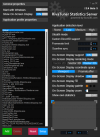Like I've said in this thread, I have a high end gaming pc and play games on it. I like pc games! I like that people play them, and that people make games for them. I think its indisputable that the platform overall -- the whole intersecting set of closed or open standards, OS developers, drivers, api design, and, yeah, the modularity, all produce a platform that undermines games in a lot of way. Some of that comes from the modularity.
If you could buy a pc with a handful of the features I called out -- a game console style OS, a single (or like, really, just a small double digit number of) hardware configuration for tens of millions of users, a set api and driver, I would feel very differently.
But PCs -- the platform created and maintained by all of the interlocking set of stakeholders who make pc hardware and software -- don't and can't have those features.
Being part of a modular platform (and being mostly consigned to the low end) (and running on general purpose operating systems) (and so on) means that nobody is really taking advantages of unified memory, when available on pcs, the way they are on consoles. And, yeah, the ps3 only failed at one of the things I rattled off and (for this reason among others) completely failed to deliver reliable performance or a stable dev environment. I still think it was designed for gaming -- I would think PCs were designed for gaming if everyone agreed to make them hit most of those features, but not all -- but the ps3's legacy is not that of a super well designed gaming machine.
PC's expand it a lot. You guys downplay this often so I think you just don't realize how bad it is! I have two assumptions here:
1- Maintaining multiple ways to do the same thing in a game engine is very costly -- not just in terms of hard work, but in terms of stability, QA coverage, just the amount of information and context switching developers need to switch between code that does the same thing radically differently, and even things like player trust -- how many games with optional dx12 toggles improved people's perception of dx12?
2- Very few of your purchasers for any pc game have the latest hardware generation. This doesn't mean they're all low end users -- lots of people bought a 1080 and then decided not to buy a 2060 or whatever later on.
The combination of these two factors means that any intrusive feature -- anything that requires rewriting large chunks of your engine or renderer -- is just not practical to roll out until ~75% or something of users have access to it. This means features people on here complain about a lot -- mesh shaders, sampler feedbakc shading, etc -- are not going to roll out any tim esoon. On consoles, the number is always 100%. That's a big deal for the industry as a whole!
I mean, it might? It's very low to the ground, it's very light weight, etc etc. It was designed with a different task in mind. You could imagine the opposite too: is a regular commuter hatchback designed for racing? I guess you could put a super fast engine and whatever else (i don't know much about cars, sorry) in it -- a skilled mechanic and driver could make it very fast. However, it's working against purpose, design elements would be in the way, it might be less stable, etc.
It isn't about the settings -- it's about the API features, see my point above about waiting for the market to have access to mesh shaders.
It feels like you guys are talking past me with some of this. I have played more games on my pc in the last week than I have any of my consoles. I'm not a console warrior or a consoles only player. PCs are a very important part of the ecosystem. But their design as a platform undermines games in many ways.
I also like playing games on mobile, and mobile is also a giant market, but if I said "you know what, there are great gaming experiences on iphone, but mobile phones aren't really designed, maintained, or intended by their stakeholders to be for gaming" I feel like nobody here would raise an eyebrow.



